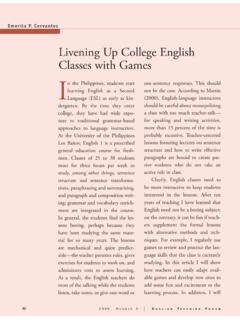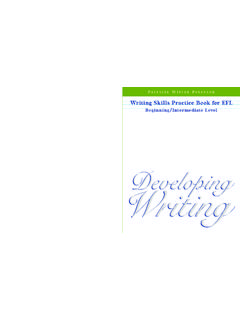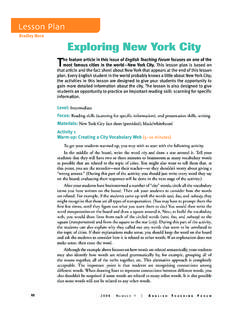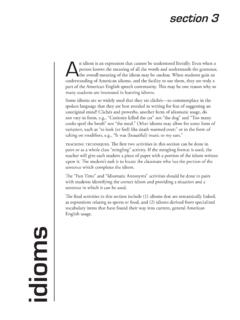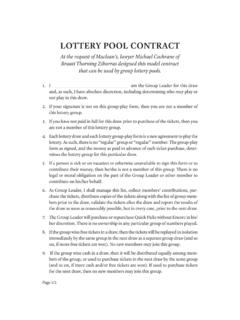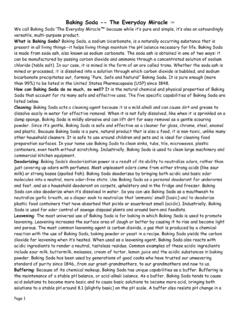Transcription of A Reference Guide to American English Idioms
1 IN THE LOOPA Reference Guide to American English IdiomsIn the Loop:A Reference Guide to American English IdiomsPublished by the Office of English Language ProgramsUnited States Department of StateWashington, DC 20037 First Edition 2010 Adapted from:Something to Crow About by Shelley Vance Laflin; ed. Anna Maria Malko , Frank SmolinskiIllustrated American Idioms by Dean CurrySpecial thanks to Elizabeth Ball for copyediting and proofreading this 2010 of English Language ProgramsBureau of Cultural and Educational AffairsUnited States Department of StateWashington, DC Each Entry is ArrangedPart 1: Idioms and DefinitionsPart 2: Selected Idioms by CategoryPart 3: Classroom ActivitiesIndexvIdiom: a group of words that means something different than the individual words it containsAs with any language, American English is full of Idioms , especially when spoken.
2 Idioms add color and texture to language by creating images that convey meanings beyond those of the individual words that make them up. Idioms are culturally bound, providing insight into the history, culture, and outlook of their users. This is because most Idioms have developed over time from practices, beliefs, and other aspects of different cultures. As a culture changes, the words used to describe it also change: some Idioms fall out of use and others develop to replace them. With Idioms in particular, the beliefs or practices leading to their use may disappear while the idiom itself continues to be used. Idioms can be so overused that they become clich s; or they can become slang or jargon, expressions used mainly by specific groups or can be complimentary or insulting.
3 They can express a wide range of emotions from excitement to depression, love to hate, heroism to cowardice, and anything in between. Idioms are also used to express a sense of time, place, or size. The range of uses for Idioms is complex and complexity of Idioms is what makes them so difficult for non-native speakers to learn. However, this complexity is also what can make Idioms so interesting to study and learn; they are rarely boring. Learning about Idioms , in this case those used in the United States, provides a way to learn not only the language, but a little about the people who use the Loop is a collection of common Idioms updated and compiled from two previous books of Idioms published by the Office of English Language Programs: Illustrated American Idioms by Dean Curry and Something to Crow About by Shelley Vance Laflin.
4 In the Loop combines the popular aspects of the previous books, while also updating the content by including Idioms that have come into use more recently and eliminating those that are rarely used. When available, background information is included about the origins of the Idioms . Additionally, In the Loop includes categories of commonly used Idioms and suggestions to the teacher to aid in developing classroom exercises for learning the meanings and uses of Idioms . In essence, this book is intended to be both a teaching tool and a of this Book. In the Loop is divided into three parts: Part 1, Idioms and Definitions ; Part 2, Selected Idioms by Category ; and Part 3, Classroom Activities. The Idioms are listed alphabetically in Part 1.
5 Part 2 highlights some of the most commonly used Idioms , grouped into categories. Part 3 contains classroom suggestions to help teachers plan appropriate exercises for their students. There is also a complete index at the back of the book listing page numbers for both main entries and cross-references for each to Locate an Idiom. In Part 1, Idioms and Definitions, Idioms are listed alphabetically by first word. The only first words not used to place the Idioms in order are articles (a, the, some) and pronouns and possessives (someone, one). Instead, these are placed at the end of the idiom, separated by a IN (ONE S) CAP, A an exceptional achievement 1. Cassandra managed through hard work to win a big contract for her company. It was a real feather in her cap.
6 2. The scholarship Lee won to attend the university was a feather in his cap. Synonym: something to crow about Antonym: nothing to write home about Compare to: feather (one s) nest The practice of placing a feather in one s cap is centuries old and appears to have been practiced in many different cultures. The feather was awarded and worn as a sign of a significant achievement by the wearer. In some cultures, such as in 16th century Hungary, it was even a crime to wear a feather when one had not earned the right to wear s main entrysample sentences using the idiomcross-referenced Idioms for comparisonadditional information about the idiomdefinition of the idiom5 The idiom (1) is given first, followed by its definition (2). Then, two or three example sentences (3) are provided to illustrate how the idiom is used.
7 Occasionally, an idiom has more than one meaning. Where this occurs, each meaning for the idiom is numbered with corresponding numbers in the sample sentences. All entries include the idiom (1), definition (2), and sample sentences (3).The final two elements cross-referenced Idioms (4) and additional information (5) are included only where relevant or available. There are three types of cross-references used: synonym, antonym, and compare to. Synonyms are expressions that have the same meaning as the idiom. Antonyms are expressions that mean the opposite of the idiom. Compare to includes expressions that might be mistaken as similar to, or related to, the idiom. In the illustrated entry above, for example, feather (one s) nest has a completely different meaning than feather in (one s) cap, even though they both refer to a feather.
8 The final section, additional information (5), includes notes such as the origins of the expression, restrictions on usage, or any additional information that might help a learner understand when and how a particular idiom is Used in the Entries. Some Idioms may have one or two alternate words that are used interchangeably without altering the meaning. One example of this is in a fix/bind/jam. In this idiom, fix, bind, or jam can be used without changing the idiom s meaning. In such cases the possible alternates are separated by a slash (/).Some Idioms require context-specific subjects or objects. In these cases someone, something, or one are placed in parenthesis within the idiom. (Someone) or (something) is used when the idiom s object is different than the subject.
9 For example, in beat (someone) to the punch, someone is a different person than the subject as in I beat him to the punch. The pronoun one is used when the subject and object of the idiom is the same person, as in ace up (one s) sleeve (He had an ace up his sleeve).How Each Entry is Arranged1 AACE IN THE HOLEa hidden but effective means of winning a conflict1. The other team thinks they can win this basketball game, but that s only because we haven t put our best player in yet. He s our ace in the It looked like the politician would lose the debate until he brought up his ace in the hole, an argument that nobody could refute. The expression originates from some forms of the card game poker, in which players have both community cards and private ( hole ) cards in their hands.
10 To have an ace in one s private hand means that one can win the game without others suspecting ahead of UP (ONE S) SLEEVEto have an effective but hidden means to accomplish something1. It looks like Joanne is going to lose, but I wouldn t be too sure. She may have an ace up her sleeve. 2. No matter how many times I think Paul might lose to me in a game of chess, he never does. He always has an ace up his sleeve and wins every expression originates from card games like poker, in which players might hide an extra ace up their sleeves to use in case they were losing the game and wanted to HEELa person s weakness or the vulnerable spot in his or her character1. We ve got to find his Achilles heel if we hope to defeat him. 2. John appears to be a highly respected citizen, but I m sure he has his Achilles was a figure in Greek mythology who was invulnerable in battle except for his heel.

